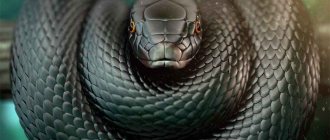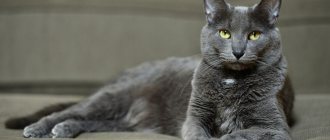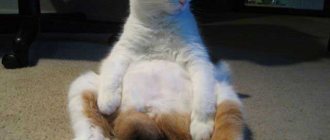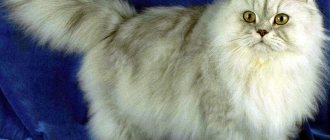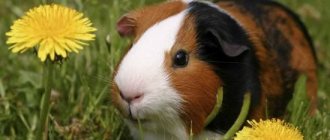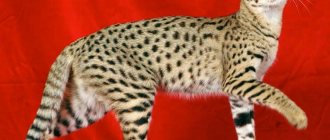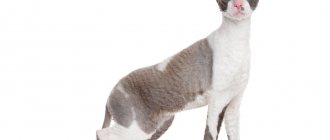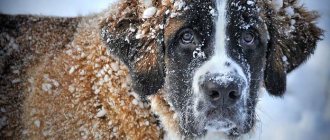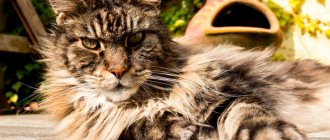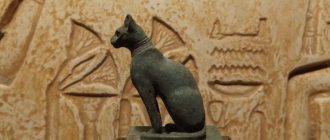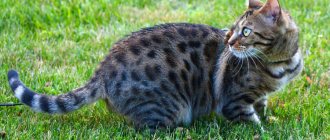Top 10 biggest cats
Among the representatives of the largest breeds of domestic cats there are long-legged, lean, short-haired beauties and shaggy hulks with a somewhat predatory appearance.
The giants of domesticated representatives of the cat world, whose weight reaches fifteen kilograms or even more, include individuals of only a few breeds, and their prices are sometimes off the charts. Pets weighing from 7 to 12 kg are not so rare, but they look no less impressive and respectable. It is worth saying that cats, invariably included in the ranking of the largest, are mainly distinguished by their physique - solid bones, powerful muscles, and not at all by how well they are fed by their adoring owners.
Without exception, all mustachioed giants reach their prime only by 3-4 years, and it is at this age that their individual weight is established. The overwhelming majority of males are much larger than females. Depending on the breed and litter, the difference in weight between them varies and can range from three to five to six kilograms.
Diseases that affect large domestic cats
The health of domestic cats, including large cats, depends on genetics, as well as how they are cared for and what they are fed. If the set of hereditary diseases depends on the breed, then the consequences of improper nutrition and maintenance are the same for all cats. They lead to pathologies such as:
- urolithiasis, although it is believed that all cats are predisposed to it. A healthy diet allows you to minimize the manifestations of the disease and the frequency of its exacerbations;
- food allergies, the cause of which in most cases is again considered to be improper feeding of the pet;
- skin problems: they can be the result of an unbalanced diet, poor care of the animal, as well as the presence of parasites in the fur;
- dysfunction of the digestive organs. In rare cases, they are caused by congenital diseases; more often they are caused by the consumption of stale, low-quality food, as well as foods prohibited for animals (for example, sweets, spicy and salty foods). In addition, the health of the digestive tract and the body as a whole is undermined by intestinal worms and protozoa. They reduce immunity and poison the internal organs of the animal with their waste products.
Diseases depending on breed
Each variety of domestic cat has a predisposition to certain diseases.
Table. Breed diseases of big cats
| Breed name | Photo | Possible health problems |
| Asherah | The breed has no genetically determined pathologies, which is explained by the good health of its ancestor, the Serval. Possible inflammation of the urinary system | |
| Maine Coon | Joint diseases (arthritis, arthrosis, osteoarthritis, hip dysplasia), skin pathologies (abscesses, phlegmon, ostiofolliculitis, eczema), disorders of the urinary system (nephritis, nephrosis, pyelitis, urethritis, cystitis) | |
| Ragdoll | Hip dysplasia, feline hypertrophic cardiomyopathy | |
| Chausie | Digestive disorders, obesity | |
| Siberian | Food allergies, inflammatory eye pathologies (conjunctivitis and others), obesity |
Savannah
Savannah, the largest domestic cat on the planet, is one of the rarest, most expensive, exotic and young breeds. Selection work on its breeding began in the 80s of the last century and took place in stages. In fact, the Savannah is a hybrid of a domestic cat and an African serval - a predatory mammal, a close relative of the lynx and caracal, but in its color this beauty is more reminiscent of a cheetah. Her homeland is the USA, or rather, one of the farms in the state of Pennsylvania, where, as a result of crossing a serval and a domestic Siamese cat, a female was born, who was named Savannah - it was she who became the ancestor of the new breed. Later, breeders included Bengal cats, Egyptian Mau, and Ocicats in the selection process. The breed standard was officially approved in 2001.
Savannah is a magnificent strong animal whose weight reaches 15 kg, and sometimes exceeds this figure. The length of the cat's body is about a meter, and the height at the withers is about half a meter. Distinctive features of her appearance are an elongated neck, a nobly set head, tall slender limbs, thick fur, and large ears.
Despite the fact that the Savannah has a wild and, one might even say, unkind look, it is not at all aggressive. This cat is quite sociable, friendly to children, devoted to its owner, understands commands perfectly, like a dog, and is ready to walk on a leash without whims. However, in urban conditions, the savannah experiences discomfort, as it needs an active lifestyle. She must be able to realize her instincts: climb to heights, hunt, jump, demonstrating the wonders of tightrope walking - from a standing position, this pet can easily “jump” 3.5 meters vertically. Savannahs are not at all afraid of water; on the contrary, they are not averse to swimming a fairly decent distance.
Not all savannahs are the same: their size and habits depend on the degree of kinship with their wild ancestor - the serval. The cats that are the least distant from the serval are those designated as an F1 hybrid. These are the heirs of the first generation of mating animals - wild and domestic. They are the largest, rarest and, accordingly, expensive. The higher the number after F, the less Serval blood the Savannah has. F7 hybrid animals, for example, are similar in build and size to a regular domestic cat. Savannah kittens can cost anywhere from $4,000 to $20,000.
In 2006, representatives announced the appearance of a new breed of cat - the Asher. These animals were the result of crossing a Bengal cat, an Asian leopard cat and a serval cat. Initially, the cost of a kitten in the nursery was 20 thousand dollars, but despite this, Ashera quickly gained popularity. It soon became clear, however, that the DNA of these felines is identical to that of the Savannah, so this breed is not recognized today as a separate breed. However, these exotic-looking cats remain in high demand, and their prices have dropped significantly.
Savannah (Asherah)
British breed - 8th place
These cats give the impression of being good-natured and gentle, but in reality this is not entirely true. Representatives of this breed will not reveal their soul to the first person they meet. However, if you gain the trust of this animal, you can find a faithful and devoted friend in him. British dogs can weigh up to eight kilograms.
Maine Coon
Second place in the list of the largest cats is occupied by Maine Coons. Giant cats of the Maine Coon breed became known in the middle of the 19th century, when they began to be shown at fairs held in the northeastern American state of Maine. Legends that Maine Coons appeared as a result of crossing domestic cats and wild animals, including raccoons and lynxes, are still popular. The Maine Coon supposedly inherited its distinctively colored tail from the raccoon, and its charming ear tufts from the lynx. These spectacular versions are beautiful, but from a genetic point of view they do not stand up to scrutiny. Dog handlers are confident that the breed formed independently, as a result of natural evolution, but is intraspecific.
Maine Coons reach maturity in their fourth year of life. At this age, their weight can be 12-15 kg. They have a large and long body, a powerful chest, well-developed muscles, thick, strong paws. In addition to their power, Maine Coons can also be proud of their luxurious thick coat. Another distinctive feature of the appearance of this animal is its incredibly fluffy tail, which the cat uses to wrap itself in the cold season.
Maine Coons have a wonderful character - soft and accommodating. They are intelligent, smart, friendly, but do not tolerate familiarity. These cats love to live in pairs. Male Maine Coons are excellent fathers, enthusiastically taking part in raising their offspring along with females.
The longest cat belongs to the Maine Coon breed. A male named Stu, a native of Nevada, is known for measuring 1.23 m from the tip of his nose to the tip of his tail.
Maine Coon
Fifth place – Puma
Puma
Other names for puma are mountain lion, cougar, panther. The puma belongs to the genus Puma. Lives in North and South America. Lives in bushes, swamps and forests. Mountain lions are solitary and territorial animals, with ranges ranging from 250 sq. km up to 950 sq. km. The puma has yellow-brown fur, straight ears, and a long tail. The animal is born with spots that disappear as they grow.
Males weigh on average from 50 to 100 kg, females - 30-65 kg . Pumas have large, strong paws and proportionately the largest hind paws in the cat family. This physique helps to jump long distances (4-12 meters) and run fast (60-80 km/h).
The puma does not roar, it makes sounds of hissing, growling, whistling, screaming. Mountain lions are active at dusk, at night, and at dawn; These are predators that eat prey of various sizes - from insects, rodents to medium and large ungulates (especially deer).
Interesting: The most predatory animals in the world - list, names, where they live, description, photos and videos
The total mountain lion population is estimated to be less than 50,000. The average lifespan in the wild is 8-13 years, in a zoo it is about 20 years.
Chausie
Large, stately and elegant Chausies are young cat breeds. They were developed in the USA in the 60s of the last century, and were registered only at the beginning of this century. The Chausie was created by crossing the Abyssinian domestic cat and the wild jungle cat, also known as the marsh lynx.
Chausies are athletically built, they have a long body, and the height at the withers can reach 40 cm, which puts them in third place in our ranking of the largest cats. The weight of an adult male reaches 14.5 kg. These amazing cats have a completely wild appearance. Their coloring, predatory look, and hunting habits make you wonder if you should be afraid of them. But upon closer acquaintance, it turns out that the chausie is the sweetest creature: affectionate, gentle, peaceful, loving to purr, and quite loudly.
From their predatory ancestors, these cats inherited a passion for hunting, a love of water and a desire to conquer heights. They love to stock up, often sneaking unattended food from the kitchen. They should be fed raw meat and fish, quail eggs; cereals are contraindicated for them.
Chausie is a very rare breed of cat because it is quite difficult to breed them. Chausies are most popular in their homeland - in the USA; there are several nurseries in Europe. In the post-Soviet space, chausie are considered a rarity. The cost of a kitten of this breed can reach $10,000.
The biggest cat in the world
Exceptional characteristics imply some distinguishing individual traits - Trouble the cat has one such trait. This male is the largest cat
Savannah was included in the Guinness Book of Records for her height. Neither more nor less, and 48 cm at the withers makes the cat exceptional. A modest weight of 9 kg contributes to increased activity, so the animal is constantly on the move. The owners of the animal are the Maraspins from Sacramento (California) and they have already received a certificate of the title of record cat.
The previous height record for a cat, 44 cm, was also set by a savannah named Scarlett's Magic.
Siberian and Neva masquerade cats
The Siberian cat is the pride of Russian breeders and the first domestic breed recognized by all international felinological organizations. The name of the breed, which began to be bred in the late 80s of the last century, is symbolic, since animals common throughout Russia, and not just Siberia, took part in the selection. The largest, strongest animals with heavy bones and thick, long hair were selected for breeding. The result turned out to be excellent: the Siberian cat looks like a real taiga inhabitant: hardy, powerful, big, harsh. The average weight of adult males is 10 kg, but 12-kg Siberians are not at all uncommon.
Siberian cats have a strong nervous system and high intelligence. They are calm, reasonable, patient with children, and attached to their owner like dogs. These cats are fearless and excellent hunters.
The Siberian cat rightfully takes fourth place in our ranking of big cats, and to it we will also add the Neva Masquerade cat, which is considered its subspecies. Breeders from the Kotofey club bred this magnificent breed under the guidance of felinologist Olga Mironova and presented it at her cat show in 1988. The Neva Masquerade cat owes its name to the Neva River, on which St. Petersburg stands, and the color of its face, similar to a carnival mask.
Today, breeding of Siberian cats is carried out in the USA, Canada, Great Britain, Germany, Spain, Italy, Finland and other countries. The number of nurseries located around the world is more than three hundred.
Siberian cat
Neva masquerade cat
Fourth place – Leopard (Panthera pardus)
Leopard
The fourth largest among wild cats is the leopard. There are 9 subspecies of leopard (African, Indian, Javan, Arabian, Anatolian, Amur, Indochinese, Sri Lankan), which are found in Africa, East and South Asia. These cats live in tropical forests, deserts, savannas, grasslands, mountains, coastal areas, scrub and swampy areas.
Leopards spend a lot of time in trees and are active mainly at night. Leopards have a muscular, flexible body, they run at a speed of 60 km/h, and jump 6 meters in length and 3 in height. Like pumas, leopards are solitary, territorial, predatory animals. Leopards roar, growl, meow. Their roar is associated with the spraying of wood.
Leopard fur color ranges from pale yellow to tan or gold. There are dark spots on the body, which are called “rosettes” because they are shaped like a rose. Males are larger and heavier than females: 40-90 kg versus 30-60 kg .
Leopards are endangered. The rarest subspecies, the Amur leopard, is found in the Far East, Korea and northeast China, with only 30 individuals in the wild. The average lifespan is 12-17 years in the wild and up to 23 years in zoos.
Ragdoll and ragamuffin
The top five largest cats in the world are ragdolls, along with their charming subspecies - ragamuffins. Ragamuffin, which means “ragamuffin” in English, is the creation of the creative American breeder Anne Baker, also known as the founder of the Ragdoll breed. Actually, Ragamuffins are ragdolls crossed with mongrel cats. Their appearance is very reminiscent of ragdolls, but these delightful creatures have a richer palette of colors. Ragamuffins can be long-haired or short-haired.
Representatives of this breed have an elongated, strong, muscular body; by the age of four years, the age of full maturity, they can gain weight up to 10 kg. Ragamuffins are similar in character to ragdolls: they are just as gentle, affectionate, in need of the love and attention of their owner, and, despite their impressive size, completely defenseless against the aggression of other animals.
The breed was introduced in 1994, but numerous ill-wishers of Ann Baker for a long time prevented the official recognition of Ragamuffins. Only in 2003 these cats received a status separate from ragdolls and were recognized by international canine organizations.
Ragdoll
Caring for big cats
Caring for any pet is the direct responsibility of a loving owner. If the cat in the house is a large breed, then the most important factor in care will be the size of the animal.
Impressive body weight can be achieved and maintained only with a properly selected, complete diet. To the weight prescribed in the big cat breed
has not become superfluous, the pet must be fed according to the schedule established by the owner. It is unacceptable to overfeed such cats!
The second important factor will be the allocation of personal space for the animal. This is not a sofa cat that will modestly occupy a corner of the blanket. This size of the animal will have to be taken into account when determining a place for it to sleep. Without walks it is impossible to maintain the muscle tone and health of a rather large pet.
global $ads_google; //data-ad-slot=”2475549904″ $ads_google = empty($ads_google) ? false : true; ?> if ($ads_google == false) {?>
$ads_google = true; ?> } ?>
Norwegian Forest Cat
Luxurious Norwegian forest cats are the pride of all of Scandinavia, where they are considered aboriginal animals. Presumably their ancient ancestors are long-haired representatives of the cat tribe brought to these harsh northern regions. As a result of natural selection and adaptation to the Scandinavian climate, they became the founders of a special population of cats - large, strong, distinguished by endurance and very thick hair. At the beginning of the last century, the Norwegian authorities provided official protection to native wild cats, obliging foresters and rangers in nature reserves to fight back against poachers who caught these beauties en masse and took them out of the country. In the 1930s, breeders began systematically breeding Norwegian forest cats to avoid extinction of the animals, while preserving their pristine beauty. The Norwegian Forest Cat breed was officially recognized only in 1977.
The Norwegian Forest Cat looks powerful yet elegant. It has a strong, elongated body, the hind limbs are noticeably longer than the front, which is more typical for a lynx than for a domestic cat. This proportion allows this animal to descend from a height head down in a spiral, like a squirrel, which is not typical for most pets. The weight of an adult male can reach 10 kg, but visually, thanks to his luxurious fur, he “pulls” a whole pound.
The Norwegian's character is as magnificent as his appearance. He is an excellent and loyal companion, very inquisitive, sociable, but not annoying. The cat is extremely friendly and is always ready to make friends with other pets.
In the second half of the last century, King Olav V of Norway gave the Norwegian Forest Cat the status of a national breed. In Western and Northern Europe, this charming animal has plenty of fans; in the USA they are not very popular, and in Russia there are only a few nurseries where you can buy a guaranteed purebred Norwegian Forest cat kitten. They operate in Moscow and St. Petersburg.
Norwegian Forest Cat
Chartreuse breed (Carthusian) - 10th place
These cats have a strong body build and a beautiful blue color. At birth, kittens have blue eyes, which become orange or copper as the cat matures. Features include a very quiet voice and large, expressive eyes. The weight of an adult cat can be up to seven kilograms.
British shorthair cat
The British Shorthair cat is one of the oldest and largest English breeds. The ancient ancestors of these animals are presumably cats, brought to Britain by Roman legionnaires before our era. Over the centuries, they have interbred not only with each other, but also with native wild cats. British Shorthair cats became known as a breed in 1871, when they were presented at the London Cat Show, after which they gained extreme popularity. However, at the beginning of the twentieth century, the fashion for these cats passed, and by the 50s their population had decreased significantly. To preserve the breed, breeders began crossing the few representatives of the British Shorthair with Persian cats, as a result of which today these cats look a little different than a century and a half ago.
The Briton is a large, but quite compact in his constitution strong man, who, thanks to his superbly sculpted muscles and unusual plush fur, looks even more powerful than he actually is. On average, adult cats weigh up to 9 kg, but some pets weigh up to 12 kg. This is usually due to the fact that representatives of this breed are prone to obesity because they become inactive as they age. By their nature, British Shorthair cats are calm and independent, they treat others selectively, and do not allow strangers to approach them at all.
There is an opinion that the illustrations for the book “Alice in Wonderland”, created by the English artist John Tenniel, depict a British shorthair cat. Today the Briton is the recognizable “face” of the Whiskas brand.
British shorthair cat
Famous giant cats, interesting facts
A representative of the Maine Coon breed entered the pages of the Guinness Book of Records due to its body length of 123 cm.
Maine Coons are often caught doing an interesting activity where they move their paws through the water. Some cats drink water by scooping it up with their paws.
Maine Coons are easy to train and follow dog commands: they bring a stick and sit on command.
A cat named Trouble, a representative of the Ashera breed, was also included in the Guinness Book of Records for body length at the withers - 48 cm. At the same time, its weight is very modest - only 9 kg, but it is this that allows the cat to perform complex tricks and move gracefully.
Representatives of the Ashera breed are marked with the designations F1-F7, which is typical for all interracial breeds. The higher the number, the less wild blood the cat has. Hybrids F1-F3 are recommended for aviary keeping. Cats with a low percentage of Serval blood can be kept indoors.
Chartreux are quite intelligent and easy to train. Some pets bring slippers to their owner and know how to open doors.
Male Siberian cats help females cope with their offspring and devote a lot of time and attention to them.
Turkish Vans love to climb on eaves, balconies, and sit on doors.
The main difference between the British cat and other large breeds is that it matures earlier . Already in one year the animals reach their maximum size. In addition, the British are famous for their faithful service to the state and are appointed to the position of the country's main rat-catchers. The whole of Great Britain was heatedly discussing the event when a cat named Larry left his post.
Pixiebob
The breed, known today as the pixie bob, was originally formed through the process of cross-breeding in natural conditions between a domestic cat and a bobcat, a wild lynx. Due to the fact that these animals have the same karyotype, their offspring turned out to be fertile. In the 80s of the last century, American felinologists, having caught three wild individuals in the forest, began breeding them, trying to preserve the original appearance of the animal. In 1998, the new breed received the right to participate in the championships of the world's largest felinological organization TICA.
Externally, the pixie bob resembles a small lynx with a short tail. He has a powerful body, strong paws, and a wild, slightly gloomy look. The weight of an adult pet is 7-9 kg. Despite its stern and menacing appearance, the pixie-bob is a fairly peaceful, calm creature. It is not aggressive, rarely releases its claws, and will not bite a person at full strength. These cats are similar to dogs in their behavior and devotion. Pixiebobs do not meow, but when they play with each other, they growl. Their purring is not like the songs of domestic cats - it is very loud and heavy. These animals do not welcome other pets, but they also do not enter into conflicts with their four-legged brethren - they simply maintain their distance.
Pixie bobs produce few offspring - there are usually 2-3 kittens in a litter. This rare breed is recognized as a national treasure of the United States. Official permission is required to take cats out of the country.
Pixiebob
Pixie bob
This cat breed is considered a national treasure of the United States and its export is prohibited by law.
The breed was bred artificially. The breeders' task was to obtain a forest lynx that was not at all large in size. All that remains of the lynx are the tassels on the ears and unique colors, as well as a short tail. Adults weigh from 5 to 8 kilograms.
Despite the presence of lynx genes, these cats are distinguished by their calmness and love for their owner.
Turkish van
The ancestors of the Turkish Van are aboriginal semi-long-haired cats, who from time immemorial lived in the area adjacent to Lake Van, located in Turkey. This breed was discovered in the modern world by British journalist Laura Lushington, a big cat lover. From her trips to this region of Turkey in the 50s of the last century, she several times brought charming kittens, with which the breeding of the Turkish Van cat breed in Europe began. Today, the Turkish Van is recognized by all leading felinological international organizations.
An adult Turkish Van cat can weigh up to 9 kg. His body is muscular, long, with a wide, powerful chest. These pets love water fun and swim well. They are very active, sociable, overly inquisitive and emotional. They have a well-developed hunting instinct. In childhood and adolescence, these cats can even show some aggressiveness, biting and scratching their owners. However, with age their character becomes softer.
In Turkey, aboriginal Van cats (they are called van kedisi here) are very revered, are one of the symbols of the country and are listed in the Red Book. They are credited with the gift of bringing happiness and good luck; these animals are even allowed to enter the mosque. It is possible to export Turkish Vans from the country only with official permission.
Turkish van
Kurilian Bobtail
The list of the largest cat breeds is replenished with another giant, since adult individuals can weigh at least 7 kilograms.
This breed of cats was once moved from the Kuril Islands to the mainland at the end of the last century.
The breed is distinguished by the original shape of its tail, which is quite short (only 8 cm maximum) and somewhat resembles a pom-pom. If a cat of this breed has a tail longer than 8 cm, then this is considered a fault of the individual, and if its length is only 12 cm, then the cat can be removed from the competition.
Kuril bobtails are not afraid of either moisture or frost, although they do not like to swim, but at the same time they are excellent at hunting fish.
The behavior of this breed of cat is somewhat reminiscent of the behavior of dogs, since they are very curious, are highly active and never refuse long walks and fun games, involving various toys, where they carry them in their owner’s teeth, like dogs.
Chartreuse
The Chartreuse, or Carthusian, as well as medieval cat, is considered a French breed. However, historians in the field of felinology are confident that the ancestors of the Chartreux are cats brought to France from the East during the Crusades. In the 16th century, they were described as stocky animals with an ash-gray color with a blue tint. Initially, these big cats lived at the main monastery of the Carthusian order of Grand Chartreuse, but over time they bred in other regions of the country. After the First World War, French breeders began systematic breeding of the breed, and in 1928, Chartreuse was already taking part in exhibitions. Today, nurseries for breeding Chartreuse are located mainly in France and the USA.
In their appearance, Chartreuse cats resemble British shorthair cats, but they have a different constitution and lack the pronounced plushness of the coat characteristic of the British. When looking at their dense, well-built, compact body and short limbs, it may seem that these pets are lightweight, however, when you pick up a Chartreuse in your arms, you will immediately understand how deceptive this impression is. Adult Chartreux have significant muscle mass and can weigh up to 7 kg. They are very balanced and measured, one might even say phlegmatic. They seem to enjoy observing rather than acting. Chartreux meows very rarely, and their voice is so quiet that it is like a whisper.
It is difficult to find purebred Chartreuse in Russia. Often, even in nurseries under the name “chartreuse” they sell shorthaired blue cats of the British breed, European shorthaired blue cats or hybrids of these breeds. You can purchase a guaranteed purebred kitten in clubs that are members of the international felinological organization FIFe.
Chartreuse
Natural enemies of the liger
Ligers are the largest cats, but they do not live in their natural habitat. In theory, if ligers settled in any territory, they would quickly rise to the top of the food chain, and they would have no natural enemies. Ligers have a number of diseases (in addition to infertility in males) that can cause serious complications for a normal life.
Ligers are prone to mental disorders. The fact is that tigers and lions have different sign systems of communication. Because of this, ligers sometimes experience problems, as a result of which they cannot understand each other or their relatives. For example, tigers and lions have different warning signal systems, so ligers may see the peaceful calls of other cats as a threat.
This situation can even be observed in the relationship between a ligress and her cubs - she may not understand their sign system, inherited from the lion father, which is why she abandons the children and they are raised by zookeepers. Ligres are prone to depression due to incompatible lifestyles. They are both socially inclined and need privacy. Because of this, ligresses even become depressed. Male ligers do not exhibit this behavior - they love to be the center of attention.
Due to their weight, ligers experience enormous pressure on their paws and spine, which can lead to diseases of the bones and joints. It is also impossible to establish the life expectancy of ligers - they live up to 24 years, but scientists are sure that the animals die due to diseases, and not due to natural death.
a lion
A noble, proud and majestic predator living in the African savannas. Lions live in families or prides. Only females hunt, often in groups. Of the entire cat family, lions are the tallest.
a lion
Some facts about lions:
- weight reaches 250 kg;
- life expectancy 10-14 years, in captivity can reach up to 20 years;
- The size of the lion in length is from 2.7 to 3 meters. One of the largest lions was 3.3 meters long;
- The usual running speed of these animals is 50 km/h, the maximum is 80 km/h.
The lion species is at risk of becoming extinct; their population in Africa has declined by 40% in recent decades.
Ragdoll, 5-9 kg
The Ragdoll is a unique breed. Kittens are born white and are very friendly with their owners. One can say even more - the owner for this breed is the center of the Universe. You always want to pet a beauty with luxurious fur; she responds to affection with a kind disposition and tenderness.
Those who often have scandals in their family should give up the idea of getting a Ragdoll, because the animal takes everything to heart, and it may even become depressed. The same applies to people who are absent all the time - the cat begins to feel sad and depressed if it is alone for a long time.
These wonderful cats with bright eyes do not require much, the most important thing is that the owner is nearby and there are no scandals in the house.
